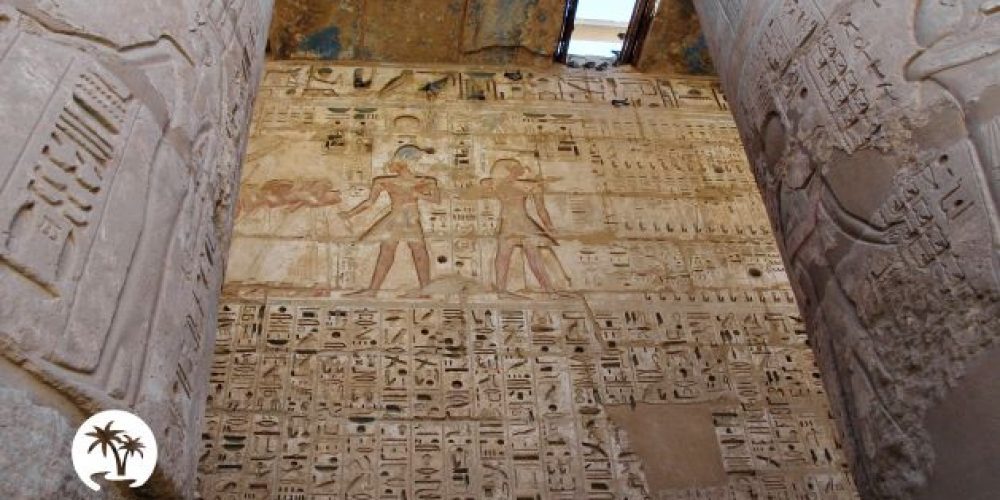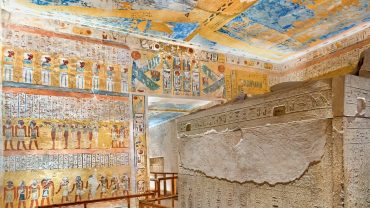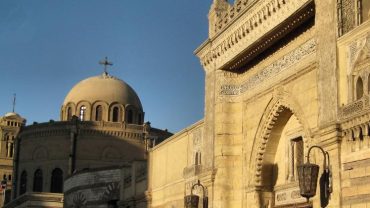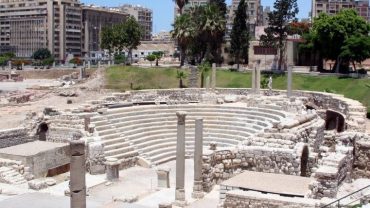Medinet Habu Temple in Luxor Egypt | Facts Pharaonic Temples, History, plane, Map The Mortuary Temple of Ramesses III The Migdol Gate…
Medinet Habu Temple in Luxor Egypt
Where is Medinet Habu Temple?
Habu temple (Medinet Habu temple) is on Luxor West Bank exactly facing Luxor temple on Luxor East Bank. The location of Habu temple was chosen on purpose and to explain why especially this place, we have to talk about one Ancient Egyptian civilization creation myth, Ogdoad of Hermopolis (Khmunu).
Religious Significance of Medinet Habu
First of all, the name, Hermopolis is a Greek name that means the city of Hermes, the matching god with the Egyptian god Thoth, the god of wisdom and knowledge.
The Egyptian called Hermopolis Khmunu means the city of the Eight. The ancient Egyptians believe in the beginning was dark, water, no borders, no order, nothing was there. In that creation Myth, they believed the Ogdoad was a system of eight deities, four males and four females or four husbands and four wives. Those eight there created the world and they were as following
Ogdoad of Hermopolis (Khmunu)
Nun and Nunet: Representing the Primordial Waters
Kuk and Kuket: Representing Darkness
Heh and Hauhet: Represented Eternity
Amun and Amunet: Representing Hiddenness
These eight gods, the females are depicted with frog heads and the males with Serpent heads. These gods and goddesses of the Ogdoad ruled the earth during the Golden Age and their power will remain to help the Nile to flow and the sun to rise every day. When they died, they left Khmunu and came to Hebo, the hidden place or Habu later.
It was necessary for them to leave a god to rule the world, so they left Amun. Amun (Amun Ka Mut.f) chose Luxor temple as a place in the city of living and Habu on the west bank as a place in the city of the dead. Amun on the living part comes yearly to visit his partners in the city of the dead at a beautiful feast called the Feast of the Valley.
Male gods take the snake shape because the snake changes his skin from time to time as the gods will renew their power from time to time. Snakes can hide and live underground and the gods can go to the underworld and come back according to their wishes. That was the reason why they chose Amun to rule over the world.

Who discovered Medinet Habu?
In ancient times, the Building Habu temple started in the 5th year of the reign of King Ramses III and it ends in the 12th year. This means Medinet Habu temple took 7 years of hard work and 3000 workers shared in the work with 40 ships to transfer the stone blocks from El Silsila quarries to Luxor. We know the name of the Head of the Workers Ba Iri but we do not know the name of the Engineer.
Important Sight in the Habu area
Because the place was very sacred, many buildings were found here but the Medinet Habu temple is still the biggest and the most beautiful one
Temple dates back to the beginning of the 18 Dynasty started by Thutmose I, Thutmose II, Queen Hatshepsut, and Thutmose III finished it
Tombs for the god’s wives of Amun of the 25th, and 26th Dynasties among them the daughter of the Kushite king Kashta, princess Amun Reds.
Buildings date back to the Greco-Roman Era & Christian Era
The town of Djeme
Facts About Medinet Habu Temple
Habu temple measures 320m from east to west and 200m from north to south
The temple took 7 years to be built
3000 workers
40 Ships
150 priests working for the temple
4 High Priests and the rest slaves and workers
65 000 employees all over Egypt to manage the temple business
Scenes are very deep inside the walls, so the stone white colors reflect the brightness of the reliefs
The main gate is called Migdol which is imitating the ancient fortified Syrian cities
Enclosure wall 18m high
2 Small Guarding rooms before the entrance
The monuments at Medinet Habu
Enclosure Wall
Eastern Gate, Migdol Gate the main entrance of the temple
Western Gate, the side gate for the priests and workers
Pylon
Courtyard of the Feasts
Hypostyle Hall
Holly of the Hollies
Royal Palace
Residential Buildings for Priests
Administrative Buildings
Barracks
Stables
Ponds
Gardens

Medinet Habu temple – Habu Temple – Mortuary temple of Ramesses III
Medinet Habu Names during history
Medinet Habu is also known as the mortuary temple of the Egyptian Pharoah king Ramesses III on the west bank of Luxor, Egypt. In ancient times Medinet Habu was known as Djabet and it was the place where Amun first appear and his friends, and the rest of the Ogdoad were buried.
Who built the temple at Medinet Habu?
The Egyptian Pharoah king Ramesses III was the 2nd king of the 19 Dynasty of The New Kingdom of Ancient Egypt, and he is the last great warrior, Pharoah. He rules Egypt for 32 years and he did very important 3 wars in his 5th, 8th, and 11th years against the Sea people. This king is the builder of the Medinet Habu temple on the West Bank of the Nile.
Medinet Habu was built and finished by Ramesses III?
The Medinet Habu temple and its enclosure walls were built by King Ramesses III but there are other buildings that were added later. For example, the temple of the New Kingdom was built by Hatshepsut and Thutmose II on the site of an old temple from the Middle Kingdom, the 12th Dynasty.
Both temples were built in the same place where it’s believed that Amun ancestors were buried. Also, we found the tombs of the wives of Amun Amenirdis I, Shepenwepet II, and Nitoket from the 21st, and 22nd Dynasties.
This title wife of Amun was very important as it was the title of the high priestess, normally the wife of the king or the wife of the high priest, and here in Medinet Habu, the wives of Amun were buried in the open court before the first Pylon and can visit by our Luxor Tours.
Why did Ramesses III choose the site of Medinet Habu?
Medinet Habu had a religious significance, it was the place where Amun appeared for the first time. The site of the mortuary temple was an ancient holy site called The Mound of Djeme.
opening hours:
Medinet Habu is open daily from 06.00 am to 17.00 pm but ticket windows close at 16.30 pm.
How to get to Medinet Habu?
If you plan to visit Medinet by limousine, taxi, bicycle, donkey, or any transportation method, you will go along the Memnon Colossi then before the end of the street, turn left, then straight then right to the temple and more about Egyptian History.
Why does the temple call Habu?
Some scholars think wrongly that the name Habu was derived from the name of the engineer Amenhotep ibn Habu which is not true. The temple called in Hieroglyphics (Het Khene met Hehe) means the united with eternity and it was the burial place of Amun ancestors called Hebo means the invisible. Amun Hebo, Amum the invisible one, and in the Greco-Roman era hebo became Habu.
Tickets
Buy the tickets at the ticket office beforehand. Tickets for Medinet Habu, Deir El Madina, Ramesseum, Valley of Nobles, and a small ticket window are situated nearby to Temple of Amenhotep & Temple of Tuthmosis, and close to Temple Tuthmosis I and Egypt Palma Tours offer best prices.
Adult: EGP 100 (14.4$)
Students with valid cards: EGP 50(5.5$)
Children aged 6-12 years: EGP 50(3 $)
Children under 6 years: FREE
Best time to visit Medinet Habu temple
Medinet Habu is one of the lesser-known temples but really a must-see. People from Cairo, Hurghada, and Marsa Alam, on daily trips plus Nile Cruises, head to Luxor but normally they know nothing about it. The temple is not as busy as other ancient sites in Luxor. So, you can o whenever you like. In the summer, early morning or at the end of the day will be better, in the winter, any time of the day.
How much it cost a ticket for a Camera in Habu Temple?
Nowadays it is allowed to use your camera or Mobil phone for free inside the temple.
Tips for visiting Medinet Habu temple?
The first piece of advice we can tell, visit the mortuary temple of Ramesses III with an archaeologist guide.
Take extra water with you and some snacks, especially in the summer months, and drink at least 5 small bottles of mineral water to not hydrate.
Small change for the WC
Do not forget to take your hat, sunglasses, and sun cream with you
Cotton dress during summer
There are many café shops facing the temple if you like to drink something or have an ice-cream
Medinet Habu temple design
The Jetty (Harbor)
Now after you bought the tickets in advance and you will reach the temple in 10 minutes walking or 5 minutes by car. In front of you, you will see part of the temple harbor which was connected to a canal connecting the temple to the River Nile.
X-ray Gate
Walk some descending steps then cross the Xray and a few meters to the front you will find two small rooms to the right and left.
Two Small single rooms
After the x-Ray gate, there are two small rooms probably to house the gatekeepers. They are decorated from the outside but not from the inside. Seems these rooms were decorated at the end of the reign of Ramesses III because we found the scenes for his son Ramesses IV. As long as we know the temples started from in out, it is logical the unfinished parts always are the first parts of the temple.
Migdol Gate of Medinet Habu
The axe of the temple is East-West and the entrance today is through the fortified east gate called Migdol. In ancient times there were two Migdol gates, the main one now or the eastern gate and it was another one facing this one on the western side. Both gates imitate Syrian Migdol fortresses but there is an opinion that the fortified towers are known in Egypt since the beginning of the early dynasties.
The sickness of the gate was 10m and the height now is 20m.the gates were not symbolic but they had a defensive function. The eastern gateway that overlooks the entrance is unusual in that it has broad windows which overlook the main entrance to the temple through the first pylon and is decorated with enemy heads at the bottom.
The reliefs of the Migdol Gate and the walls before it
First Relief
The King is offering Maat to Ptah and Sekhmet means the king is the one who is responsible to keep the Maat, the balance for the people and the gods. The king is the living God of the temple and he is the one who hears the prayers inside the temple. We can see the King’s hair, and false beard was inlaid with precious stones but not anymore.
There are two Sekhmet statues on the right side and on the left side but this is not the original place where they were found. They brought them to this place when booking Luxor Day Trip from Soma Bay.




Comment (0)